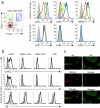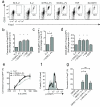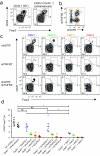Costimulation via the tumor-necrosis factor receptor superfamily couples TCR signal strength to the thymic differentiation of regulatory T cells
- PMID: 24633226
- PMCID: PMC4000541
- DOI: 10.1038/ni.2849
Costimulation via the tumor-necrosis factor receptor superfamily couples TCR signal strength to the thymic differentiation of regulatory T cells
Abstract
Regulatory T cells (Treg cells) express members of the tumor-necrosis factor (TNF) receptor superfamily (TNFRSF), but the role of those receptors in the thymic development of Treg cells is undefined. We found here that Treg cell progenitors had high expression of the TNFRSF members GITR, OX40 and TNFR2. Expression of those receptors correlated directly with the signal strength of the T cell antigen receptor (TCR) and required the coreceptor CD28 and the kinase TAK1. The neutralization of ligands that are members of the TNF superfamily (TNFSF) diminished the development of Treg cells. Conversely, TNFRSF agonists enhanced the differentiation of Treg cell progenitors by augmenting responsiveness of the interleukin 2 receptor (IL-2R) and transcription factor STAT5. Costimulation with the ligand of GITR elicited dose-dependent enrichment for cells of lower TCR affinity in the Treg cell repertoire. In vivo, combined inhibition of GITR, OX40 and TNFR2 abrogated the development of Treg cells. Thus, expression of members of the TNFRSF on Treg cell progenitors translated strong TCR signals into molecular parameters that specifically promoted the development of Treg cells and shaped the Treg cell repertoire.
Figures







References
-
- Klein L, Hinterberger M, Wirnsberger G, Kyewski B. Antigen presentation in the thymus for positive selection and central tolerance induction. Nat Rev Immunol. 2009;9:833–844. - PubMed
-
- Brunkow ME, et al. Disruption of a new forkhead/winged-helix protein, scurfin, results in the fatal lymphoproliferative disorder of the scurfy mouse. Nat Genet. 2001;27:68–73. - PubMed
-
- Wildin RS, et al. X-linked neonatal diabetes mellitus, enteropathy and endocrinopathy syndrome is the human equivalent of mouse scurfy. Nat Genet. 2001;27:18–20. - PubMed
Publication types
MeSH terms
Substances
Grants and funding
- F31 CA183226/CA/NCI NIH HHS/United States
- AI061165/AI/NIAID NIH HHS/United States
- CA154998/CA/NCI NIH HHS/United States
- F30 DK100159/DK/NIDDK NIH HHS/United States
- R01 AI101407/AI/NIAID NIH HHS/United States
- AI101407/AI/NIAID NIH HHS/United States
- R01 HL062683/HL/NHLBI NIH HHS/United States
- T32 AI007313/AI/NIAID NIH HHS/United States
- 5T32GM008244/GM/NIGMS NIH HHS/United States
- R01 CA151845/CA/NCI NIH HHS/United States
- P30 CA077598/CA/NCI NIH HHS/United States
- R01 CA154998/CA/NCI NIH HHS/United States
- 2T32AI007313/AI/NIAID NIH HHS/United States
- AI088209/AI/NIAID NIH HHS/United States
- HL062683/HL/NHLBI NIH HHS/United States
- F30 DK096844/DK/NIDDK NIH HHS/United States
- NS64599/NS/NINDS NIH HHS/United States
- R01 AI088209/AI/NIAID NIH HHS/United States
- P01 AI035296/AI/NIAID NIH HHS/United States
- R56 AI061165/AI/NIAID NIH HHS/United States
- R01 AI061165/AI/NIAID NIH HHS/United States
- CA151845/CA/NCI NIH HHS/United States
- R01 NS064599/NS/NINDS NIH HHS/United States
- R37 AI105887/AI/NIAID NIH HHS/United States
- F30DK096844/DK/NIDDK NIH HHS/United States
- T32 GM008244/GM/NIGMS NIH HHS/United States
- F30DK100159/DK/NIDDK NIH HHS/United States
- 1F31CA183226/CA/NCI NIH HHS/United States
LinkOut - more resources
Full Text Sources
Other Literature Sources
Molecular Biology Databases
Miscellaneous

